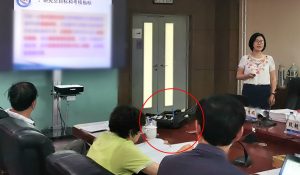 By Stephen Chen for South China Morning Post
By Stephen Chen for South China Morning Post
China has developed the world’s first portable sonic gun for riot control, the Chinese Academy of Sciences said.
The
rifle-shaped instrument, which was jointly developed with military and
law enforcement, is designed to disperse crowds using focused waves of
low frequency sound, the academy’s Technical Institute of Physics and
Chemistry website said on Wednesday.
The
device’s “biological effect” would cause extreme discomfort, with
vibrations in the eardrums, eyeballs, stomach, liver, and brain,
scientists said.
Studies dating to the 1940s found that low frequency sound energy could, depending upon intensity and exposure, cause dizziness, headaches, vomiting, bowel spasms, involuntary defecation, organ damage and heart attacks.
Sonic
weapons are typically large and have to be mounted on vehicles. Until
the Chinese development, which has no moving parts, they were powered by
electricity to drive a magnetic coil to generate energy. This meant
they needed a large and stable source of power.
The Chinese government launched the sonic weapon programme in 2017 and its conclusion is unlikely to be related to the months of anti-government protests in Hong Kong.
Professor
Xie Xiujuan, lead scientist on the project, said the device was powered
by a tube-shape vessel containing an inert gas. When heated, the gas
particles vibrate and a deep, monotonous sound is emitted.
The prototype had passed field and third-party tests and the project team has completed its assessment of the device’s effects on the body, the academy said.
A Los Angeles police officer stands by a sound cannon at a demonstration in Anaheim – Chinese scientists say they have taken the technology to a new level. Photo: AFPChina has developed the world’s first portable sonic gun for riot control, the Chinese Academy of Sciences said.
The
rifle-shaped instrument, which was jointly developed with military and
law enforcement, is designed to disperse crowds using focused waves of
low frequency sound, the academy’s Technical Institute of Physics and
Chemistry website said on Wednesday.
The
device’s “biological effect” would cause extreme discomfort, with
vibrations in the eardrums, eyeballs, stomach, liver, and brain,
scientists said.
Studies
dating to the 1940s found that low frequency sound energy could,
depending upon intensity and exposure, cause dizziness, headaches,
vomiting, bowel spasms, involuntary defecation, organ damage and heart
attacks.
Professor
Xie Xiujuan discusses the portable sonic rifle (circled) with the
government science panel sent to evaluate it. Photo: CASShare:
Sonic
weapons are typically large and have to be mounted on vehicles. Until
the Chinese development, which has no moving parts, they were powered by
electricity to drive a magnetic coil to generate energy. This meant
they needed a large and stable source of power.
The Chinese government launched the sonic weapon programme in 2017 and its conclusion is unlikely to be related to the months of anti-government protests in Hong Kong.SUBSCRIBE TO US China Trade WarGet updates direct to your inboxBy registering, you agree to our T&C and Privacy Policy
Professor
Xie Xiujuan, lead scientist on the project, said the device was powered
by a tube-shape vessel containing an inert gas. When heated, the gas
particles vibrate and a deep, monotonous sound is emitted.
On
September 4, a panel of scientists and engineers representing the
Ministry of Science and Technology met in Beijing and approved a design
developed by Xie’s team for mass production.
“The
panel suggested that the fruit of the project should be transformed
into practical equipment as soon as possible,” the academy said.
In a photograph on the institute’s website, the device could be seen on a meeting room table as the experts deliberated. It looked similar to a rifle, with a stock, trigger and barrel.
Xie refused to reveal details of the device’s frequency or its effective range. She also declined to comment on its uses without approval from higher authorities.
https://www.scmp.com/news/china/science/article/3028071/chinese-scientists-develop-handheld-sonic-weapon-crowd-control
 By the Children’s Health Defense Team
By the Children’s Health Defense Team 

 By Clintel
By Clintel By Stephen Chen for South China Morning Post
By Stephen Chen for South China Morning Post